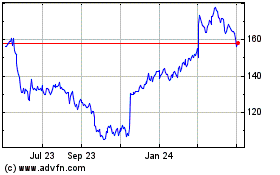Whole Foods Tries Balancing Act -- WSJ
April 18 2017 - 3:02AM
Dow Jones News
Grocer aims to trim prices but keep its cachet by offering
locally sourced items
By Annie Gasparro and Heather Haddon
Whole Foods Market Inc. wants to cut prices without sacrificing
the local products that define its healthy image.
Investors are pushing the organic food pioneer to boost profit
by operating more like a big-box grocer. Some smaller suppliers and
industry consultants say the shift to a more centralized
distribution structure and other changes risk compromising Whole
Foods' ability to keep stocked with the latest foodie trends and
hot local brands.
"Shifting to national buyers can certainly deliver cost savings
to Whole Foods, but at what price to the soul of the banner?" said
Jim Cusson of brand consultancy Theory House.
Many of the changes are being spearheaded by Don Clark, a former
Target Corp. executive hired in November 2015 to run Whole Foods'
grocery operations. The data analytics, centralized purchasing and
strict shelf management he brought from Target could save money
that Whole Foods can use to lower its relatively high prices,
addressing a key customer complaint. But matching its competitors
on price could also mean limiting how often it updates the products
Whole Foods stocks.
Whole Foods has long divided its 462 stores into 11 regions,
each with distinct product offerings like local maple syrup and
gourmet pickles. A quarter of Whole Foods shoppers that visited the
chain in the past month did so for items they couldn't find
elsewhere, according to a survey by Kantar Retail. For those who
also shopped at Wal-Mart Stores Inc., only 3% said exclusive brands
were a top draw.
The shift comes as Whole Foods looks for a way out its longest
stretch of same-store sales declines since going public in 1992.
Whole Foods is under pressure from Jana Partners LLC, which last
week said that along with allies it had amassed an 8.8% stake in
Whole Foods. The firm is pushing for faster operational
changes.
Major grocery stores like Kroger Co. and Albertsons Cos. have
seen annual sales increases of more than 10% in recent years for
natural and organic foods, eating into Whole Foods' core business.
Stealing that business from Whole Foods and other specialty stores
has been a rare bright spot for big grocery chains battling more
competition and falling food prices, which has sparked a price war
that has eaten into profits.
Whole Foods co-founder and Chief Executive John Mackey said his
chain remains a specialty store even as it adopts more conventional
techniques.
"Our culture is still very unique," Mr. Mackey recently told The
Wall Street Journal. "What Whole Foods needs to do is to take the
best ideas of the traditional supermarket industry and integrate
them into our company."
He said his new strategy strikes a balance between the remaining
autonomy of regional executives and an easier process for national
brands to pitch their products just once at Whole Foods' Austin,
Texas, headquarters. That streamlining will lead to lower prices,
he said.
"We think there are tremendous savings we can have that we can
pass on to our customers with lower prices," he said.
But smaller brands and people who work with them say they have
less incentive to put up with a more impersonal Whole Foods. "It's
not a great launching pad for brands anymore, and there are plenty
of other options," said brand consultant Jeff Grogg.
Aaron Glassman, owner of SOL Natural Foods, said that as a small
company, the changes are making it harder to get on shelves at
Whole Foods. "They have condensed the purchasing powers into less
people. It makes it more challenging," he said.
A.C. Gallo, Whole Foods' president and chief operating officer,
said small suppliers will still have access to the brand's national
store network, and that the approach will allow executives to
better monitor how well local products are performing.
And some big brands say Whole Foods' regionalized approach made
it tough to negotiate a nationwide strategy for their brands.
"It's always been difficult for everyone to commit the resources
and big ideas to Whole Foods when it took a region-by-region"
approach, said John Foraker, chief executive of Annie's Homegrown,
a large Whole Foods supplier of macaroni and cheese and snacks like
crackers.
Rick Cunnington, a 63-year-old retiree in a suburb of Tucson,
Ariz., said he is glad Whole Foods plans to focus on price over the
diversity of its offerings. Though he has shopped at Whole Foods
for years, he said, he buys many items like cheese and vegetables
at Trader Joe's where they are cheaper.
"I'll keep an open mind, especially if there are coupons
involved," Mr. Cunnington said about Whole Foods's efforts to
appeal to more shoppers. "My wife and I are value shoppers."
Write to Annie Gasparro at annie.gasparro@wsj.com and Heather
Haddon at heather.haddon@wsj.com
(END) Dow Jones Newswires
April 18, 2017 02:47 ET (06:47 GMT)
Copyright (c) 2017 Dow Jones & Company, Inc.
Target (NYSE:TGT)
Historical Stock Chart
From Mar 2024 to Apr 2024

Target (NYSE:TGT)
Historical Stock Chart
From Apr 2023 to Apr 2024
